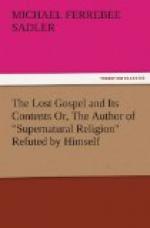Again, St. John alone speaks of our Lord as representing Himself to be the true vine, and His people as the branches. Justin uses the same figure with respect to the people or Church of God:—
“Just as if one should eat away the fruit-bearing parts of it vine, it grows up again, and yields other branches flourishing and fruitful; even so the same thing happens to us. For the vine planted by God and Christ the Saviour is His People.” (Dial. ch. cx.)
Again, St. John alone represents our Saviour as saying, “I have power to lay [my life] down, and I have power to take it again. This commandment have I received of my Father.” (John x. 18) And Justin says of Christ that, in fulfilment of a certain prophecy,—
“He is to do something
worthy of praise and wonderment, being about
to rise again from the dead
on the third day after the Crucifixion,
and this He has obtained from
the Father.” (Dial. ch. c.)
Some of these last instances which I have given are reminiscences rather than reproductions; but like all other reminiscences they imply things remembered, sometimes not perfectly correctly, and so not applied as applied in the original; but they are all real reminiscences of words and things to be found only in our fourth Gospel.
SECTION X.
The principal witness.—His testimony summed up.
From all this it is clear that Justin had not only seen and reverenced St. John’s Gospel, but that his mind was permeated with its peculiar teaching.
I hesitate not to say that, if a man rejects the evidence above adduced, he rejects it because on other grounds he is determined, cost what it may, to discredit the Fourth Gospel.
Let us briefly recapitulate.
Justin reproduced the doctrine of the Logos, using the words of St. John. He asserted the Divine and human natures of the Son of God in the words of St. John, or in exactly similar words. He reproduced that peculiar teaching of our Lord, to be found only in St. John, whereby we are enabled to hold the true and essential Godhead of Christ without for a moment holding that He is an independent God. He reproduced the doctrine of the Logos being, even before His Incarnation, in every man as the “true light” to enlighten him.
He reproduces the doctrine of the Sacraments in terms to be found only in the Fourth Gospel. He reproduces, or alludes to, arguments and types and prophecies and historical events, only to be found in St. John’s Gospel.
It seems certain, then, that if Justin was acquainted with any one of our four Gospels, that Gospel was the one according to St. John.
What answer, the reader will ask, does the author of “Supernatural Religion” give to all this? Why, he simply ignores the greater part of these references (we trust through ignorance of their existence), and takes notice of some three or four, in which, to use the vulgar expression, he picks holes, by drawing attention to discrepancies of language or application, and dogmatically pronounces that Justin could not have known the fourth Gospel.




